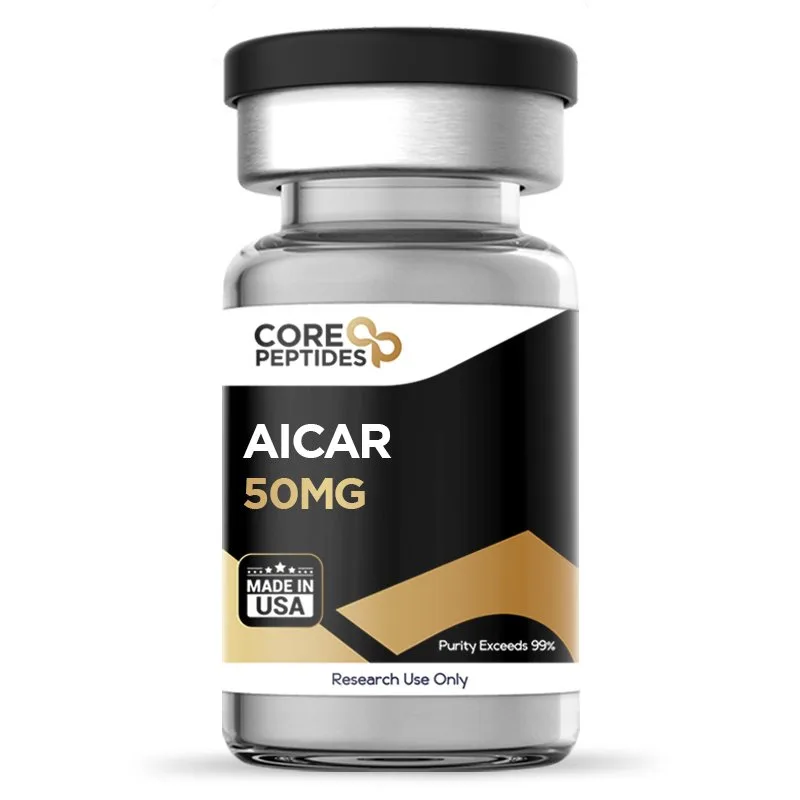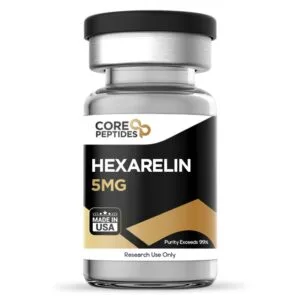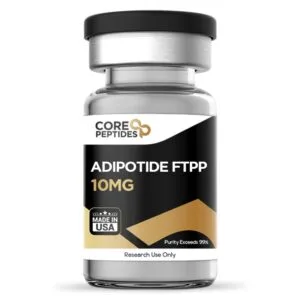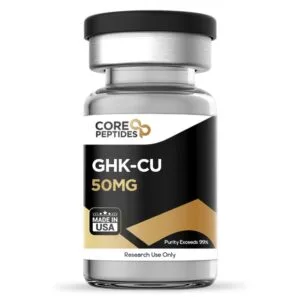AICAR (50mg)
$62.00
Size: 50mg
Contents: AICAR
Form: Lyophilized powder
Purity: >99%
SKU: P-AICAR
FREE Shipping on $200+ orders
Discount per Quantity
| Quantity | Discount | Price |
|---|---|---|
| 5 - 8 | 5% | $58.90 |
| 9 + | 10% | $55.80 |
AICAR Peptide
AICAR is an analog of adenosine monophosphate (AMP), a nucleotide that is considered to play an important role in cellular energy metabolism. It has been studied for its potential applications in research, particularly in reducing reperfusion injury after tissue ischemia and mitigating metabolic disorders. AICAR has been suggested to exert this potential by apparently activating AMP-activated protein kinase (AMPK), an enzyme that regulates various metabolic processes. AMPK potentially plays a role in restoring energy balance. It might do this by inhibiting anabolic processes: energy-consuming pathways like protein and fatty acid synthesis. Simultaneously, it might activate catabolic processes, such as the breakdown of glucose and fats, which generate ATP, thereby increasing the energy supply. There is also a possibility that AMPK influences various other cellular processes, including autophagy (the process by which cells clean out damaged components), mitochondrial biogenesis (the creation of new mitochondria), and the regulation of inflammation and stress responses. This broad range of actions suggests that AMPK might be involved in regulating several aspects of cellular and organismal function.
By potentially activating AMPK, AICAR is posited to possibly increase glucose uptake in skeletal muscle, enhance insulin sensitivity, and improve glucose tolerance. AICAR has also been suggested by researchers to have anti-inflammatory potential and may improve physical performance in certain experimental models.
Chemical Makeup
Molecular formula: C9H15N4O8P
Molecular Weight: 338.21 g/mol
Other known titles: AICA ribonucleotide
Research and Clinical Studies
AICAR Peptide and Tissue Protection
AICAR may have organ-protective potential, especially against ischemia and reperfusion injury. The nucleotide has been suggested to potentially reduce myocardial infarction size and improve cardiac function in an animal model of myocardial ischemia-reperfusion injury.(1)
One meta-analysis aimed to investigate the potential of AICAR on cardiovascular tissues.(2) The data was collected from 5 randomized, placebo-controlled, double-blind clinical studies. From the results, AICAR was suggested to reduce myocardial tissue infarction size and cardiac cell death and apparently improve the overall outcome of the experiment. The study concluded that AICAR may "reduce [...] adverse cardiovascular outcomes."
Researchers posited that the apparent protective potential of AICAR may be due to its action on cellular metabolism. AICAR may potentially alter it to become more resistant to lack of oxygen by apparently upregulating the availability of energy that can be used even in anaerobic conditions. One such process is the apparent increase in the availability of myocardial glucose. To achieve that, AICAR may promote myocardial glycogenolysis (glycogen degradation) by activating AMPK. This was suggested by experiments using isolated hearts from halothane-anesthetized murine models. In these studies, AICAR appeared to increase glycogenolysis in the myocardium of murine models, while its action on glycogen synthesis was reportedly negligible. This observation hints at a potential role for AMPK activation in glycogenolysis. Further, AICAR was noted to potentially increase myocardial levels of 5-aminoimidazole-4-carboxamide 1-beta-d-ribofuranotide (ZMP), which is AICAR's active intracellular form. However, there was no apparent change in the activity of glycogen synthase (GS) and glycogen phosphorylase (GP) in tissue homogenates, nor did AICAR seem to affect the levels of glucose-6-phosphate and adenine nucleotides in freeze-clamped tissues of these murine models. These findings suggest the possibility that ZMP might allosterically activate GP, leading to glycogenolysis in the intact hearts of the murine models, thereby providing glucose that can be used for energy even in less optimal conditions for the cells.(3)
AICAR may have protective action in other tissues as well. One study investigated the potential of AICAR, an AMPK activator, on an experimental murine model of ethanol-induced hepatic steatosis.(4) The study observed that chronic ethanol exposure appeared to result in a histologically and biochemically fatty liver. Upon AICAR presentation, it appeared to attenuate the degree of change in the liver tissues. AICAR was also posited to decrease the hepatic sterol regulatory element-binding protein 1c (SREBP-1c) and reduce fatty acid synthase (FAS) enzyme expression, reducing triglyceride synthesis in murine models’ livers. SREBP-1c is posited to be a protein apparently involved in lipid metabolism, primarily in liver tissues. It is a member of the SREBP family, which appears to be transcription factors that regulate the expression of genes required to synthesize cholesterol, fatty acids, and triglycerides. Therefore, it is possible that a decrease in SREBP-1c might lead to a reduction in fatty acid synthesis. FAS is an enzyme that is considered to play a crucial role in synthesizing fatty acids. It is suggested to play a role in the process of converting acetyl-CoA and malonyl-CoA, small molecules, into palmitate, a long-chain saturated fatty acid. FAS expression also appears to be regulated by SREBP-1c.
AICAR Peptide and Insulin Sensitivity
Studies suggest that AICAR may have the potential to improve the insulin sensitivity of various tissues due to its potential to activate the AMPK inside cells and make them draw in glucose. One experimental model aimed to investigate whether AICAR could potentially enhance glucose transport in equine skeletal muscle.(5) Upon presentation, AICAR appeared to decrease glucose and increase insulin concentration without affecting lactate concentration. AICAR was also observed to potentially increase the ratio of phosphorylated to total AMPK in skeletal muscle and may have upregulated GLUT8 protein expression. The apparent increase in the expression of the GLUT8 protein in the cells could potentially enhance the movement of glucose into cells, thereby possibly improving insulin sensitivity.
A study also aimed to determine whether AICAR may stimulate glucose uptake in muscle.(6) AICAR and physical activity were employed to stimulate muscle AMPK activity and glucose uptake. Results expressed the possibility that both AICAR and physical activity may increase glucose uptake in muscle. Still, AICAR may also increase glucose uptake in other tissues, thereby potentially increasing peripheral and overall insulin sensitivity. Researchers also suggested that AICAR might potentially increase the phosphorylation of extracellular signal-regulated kinase 1/2. Phosphorylation is a chemical process where a phosphate group is added to the enzymes ERK1 and ERK2. These enzymes are part of a specific signaling pathway known as the MAP kinase/ERK pathway, posited to regulate various cellular activities like division, differentiation, and response to stress.
Another study observed that AICAR may potentially reduce hepatic tissues’ glucose output, lower glucose concentrations, stimulate hepatic tissues’ fatty acid oxidation, and inhibit lipolysis, thereby reducing plasma-free fatty acid availability.(7) Although AMPK phosphorylation in skeletal muscle was not reported to be increased, the researchers reported acetyl-CoA carboxylase phosphorylation to be significantly increased. This enzyme is considered to play a potential role in fatty acid metabolism. It apparently catalyzes acetyl-CoA conversion to malonyl-CoA, a crucial step in fatty acid synthesis. Thus, this inactivation could potentially lead to a decrease in fatty acid synthesis and an apparent increase in fatty acid oxidation to fuel the cells with energy.
AICAR Peptide and Endurance
Researchers posit that AICAR may potentially activate AMPK, glycogen phosphorylase, and fructose-1,6-bisphosphatase.(8) Some studies have suggested these potential actions may contribute to enhanced oxidative metabolism and mitochondrial biogenesis.(9) Increasing the number and function of mitochondria may benefit muscle endurance. For example, one experiment suggested that AICAR may induce metabolic genes and enhance running endurance in sedentary murine models by 44%.(10) The results suggest that peptides may target the AMPK-PPARδ pathway to enhance training adaptation or increase endurance without exercise. PPARδ, or Peroxisome Proliferator-Activated Receptor Delta, is a type of nuclear receptor that possibly plays a role in regulating genes involved in energy metabolism. It is thought that PPARδ may be involved in processes like fat-burning and mitochondrial biogenesis (the creation of new mitochondria, which are the energy-producing structures in cells). The AMPK-PPARδ pathway potentially represents a link between the sensing of energy status by AMPK and the gene regulatory functions of PPARδ. When activated, this pathway might promote adaptations in muscle cells similar to those induced by endurance training. These adaptations could include increased mitochondrial content and a shift in muscle fiber type towards more endurance-oriented fibers, potentially leading to enhanced endurance capacity.(10)
Another experiment in murine models(11) also reported that the presentation of "an agonist of the AMP-activated protein kinase showed an increase in endurance compared to exercise-trained controls." Furthermore, in a murine model for Duchene muscular dystrophy, AICAR was observed by researchers to have the potential to enhance the impact of exercise and improve muscle function, probably by stimulating autophagy.(12) An infusion of AICA-riboside resulted in increment-correlated increases in forearm blood flow but did not appear to impact glucose uptake in skeletal muscle. The increase in blood flow appeared to be mediated by nitric oxide, as an inhibitor of endothelial NO synthase apparently attenuated it. These findings suggest that AICAR may exert impact in improving blood flow into muscle and acting as a NO-booster, which is also an important factor for improving performance during prolonged physical activity.(13)
AICAR Peptide and Malignant Cell Lines
Research indicates that AICAR may trigger apoptosis in B-cell chronic lymphocytic leukemia (B-CLL) test models. One study proposes that this process might involve the activation of caspase-3, -8, and -9, along with the release of cytochrome C.(14) Additionally, incubating B-CLL cells with AICAR seems to lead to the phosphorylation of AMPK, hinting at AICAR's potential role in activating this protein. The research further explored whether the entry of AICAR into the cell and its conversion to AICA ribotide (ZMP) is necessary for apoptosis. It employed inhibitors like Nitrobenzylthioinosine (NBTI), 5-iodotubercidin, and adenosine. These inhibitors were suggested to potentially reduce AICAR-induced apoptosis and AMPK phosphorylation. However, inhibitors of protein kinase A and mitogen-activated protein kinases did not appear to prevent AICAR-induced apoptosis in B-CLL cells.
The study also noted that AICAR did not appear to affect p53 levels or phosphorylation, suggesting a p53-independent apoptosis mechanism in B-CLL cells. A comparison was made between normal B lymphocytes, T cells, and B-CLL cells' sensitivity to AICAR-induced apoptosis. The findings indicated that normal B lymphocytes and B-CLL cells were similarly sensitive to AICAR-induced apoptosis, whereas T cells from B-CLL subjects appeared to show only minor sensitivity. Notably, AMPK phosphorylation did not seem to occur in T cells exposed to AICAR. Furthermore, upon exposure to AICAR, B-CLL cells appeared to have higher intracellular levels of ZMP compared to T cells. This observation suggests that ZMP accumulation may be crucial in activating AMPK and inducing apoptosis in these cells.
AICAR peptide is available for research and laboratory purposes only. Please review and adhere to our Terms and Conditions before ordering.
References:
- Cieslik, K. A., Taffet, G. E., Crawford, J. R., Trial, J., Mejia Osuna, P., & Entman, M. L. (2013). AICAR-dependent AMPK activation improves scar formation in the aged heart in a murine model of reperfused myocardial infarction. Journal of molecular and cellular cardiology, 63, 26–36. https://doi.org/10.1016/j.yjmcc.2013.07.005
- Mangano D. T. (1997). Effects of acadesine on myocardial infarction, stroke, and death following surgery. A meta-analysis of the 5 international randomized trials. The Multicenter Study of Perioperative Ischemia (McSPI) Research Group. JAMA, 277(4), 325–332. https://doi.org/10.1001/jama.277.4.325
- Longnus, S. L., Wambolt, R. B., Parsons, H. L., Brownsey, R. W., & Allard, M. F. (2003). 5-Aminoimidazole-4-carboxamide 1-beta -D-ribofuranoside (AICAR) stimulates myocardial glycogenolysis by allosteric mechanisms. American journal of physiology. Regulatory, integrative and comparative physiology, 284(4), R936–R944. https://doi.org/10.1152/ajpregu.00319.2002
- Tomita, K., Tamiya, G., Ando, S., Kitamura, N., Koizumi, H., Kato, S., Horie, Y., Kaneko, T., Azuma, T., Nagata, H., Ishii, H., & Hibi, T. (2005). AICAR, an AMPK activator, has protective effects on alcohol-induced fatty liver in rats. Alcoholism, clinical and experimental research, 29(12 Suppl), 240S–5S. https://doi.org/10.1097/01.alc.0000191126.11479.69
- de Laat, M. A., Robinson, M. A., Gruntmeir, K. J., Liu, Y., Soma, L. R., & Lacombe, V. A. (2015). AICAR administration affects glucose metabolism by upregulating the novel glucose transporter, GLUT8, in equine skeletal muscle. Veterinary journal (London, England : 1997), 205(3), 381–386. https://doi.org/10.1016/j.tvjl.2015.05.018
- Cuthbertson, D. J., Babraj, J. A., Mustard, K. J., Towler, M. C., Green, K. A., Wackerhage, H., Leese, G. P., Baar, K., Thomason-Hughes, M., Sutherland, C., Hardie, D. G., & Rennie, M. J. (2007). 5-aminoimidazole-4-carboxamide 1-beta-D-ribofuranoside acutely stimulates skeletal muscle 2-deoxyglucose uptake in healthy men. Diabetes, 56(8), 2078–2084. https://doi.org/10.2337/db06-1716
- Boon, H., Bosselaar, M., Praet, S. F., Blaak, E. E., Saris, W. H., Wagenmakers, A. J., McGee, S. L., Tack, C. J., Smits, P., Hargreaves, M., & van Loon, L. J. (2008). Intravenous AICAR administration reduces hepatic glucose output and inhibits whole body lipolysis in type 2 diabetic patients. Diabetologia, 51(10), 1893–1900. https://doi.org/10.1007/s00125-008-1108-7
- Višnjić D, Lalić H, Dembitz V, Tomić B, Smoljo T. AICAr, a Widely Used AMPK Activator with Important AMPK-Independent Effects: A Systematic Review. Cells. 2021 May 4;10(5):1095. doi: 10.3390/cells10051095. PMID: 34064363; PMCID: PMC8147799.
- Hardie DG. AMP-activated protein kinase: an energy sensor that regulates all aspects of cell function. Genes Dev. 2011 Sep 15;25(18):1895-908. doi: 10.1101/gad.17420111. PMID: 21937710; PMCID: PMC3185962.
- Narkar, V. A., Downes, M., Yu, R. T., Embler, E., Wang, Y. X., Banayo, E., Mihaylova, M. M., Nelson, M. C., Zou, Y., Juguilon, H., Kang, H., Shaw, R. J., & Evans, R. M. (2008). AMPK and PPARdelta agonists are exercise mimetics. Cell, 134(3), 405–415. https://doi.org/10.1016/j.cell.2008.06.051
- Goodyear, L. J. (2008). The exercise pill—too good to be true?. New England Journal of Medicine, 359(17), 1842-1844.
- Bueno Júnior, C. R., Pantaleão, L. C., Voltarelli, V. A., Bozi, L. H., Brum, P. C., & Zatz, M. (2012). Combined effect of AMPK/PPAR agonists and exercise training in mdx mice functional performance. PloS one, 7(9), e45699. https://doi.org/10.1371/journal.pone.0045699
- Bosselaar, M., Boon, H., van Loon, L. J., van den Broek, P. H., Smits, P., & Tack, C. J. (2009). Intra-arterial AICA-riboside administration induces NO-dependent vasodilation in vivo in human skeletal muscle. American journal of physiology. Endocrinology and metabolism, 297(3), E759–E766. https://doi.org/10.1152/ajpendo.00141.2009
- Campàs, C., Lopez, J. M., Santidrián, A. F., Barragán, M., Bellosillo, B., Colomer, D., & Gil, J. (2003). Acadesine activates AMPK and induces apoptosis in B-cell chronic lymphocytic leukemia cells but not in T lymphocytes. Blood, 101(9), 3674–3680. https://doi.org/10.1182/blood-2002-07-2339






